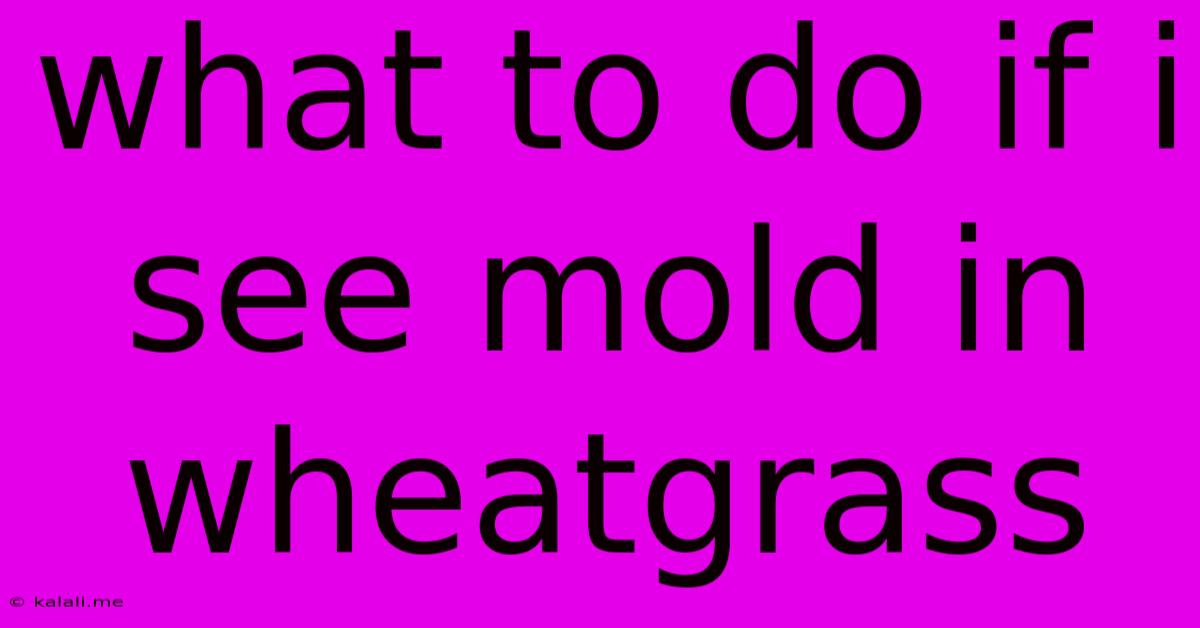What To Do If I See Mold In Wheatgrass
Kalali
May 30, 2025 · 3 min read

Table of Contents
What to Do If You See Mold in Your Wheatgrass
Discovering mold in your carefully cultivated wheatgrass is disheartening, but it's a common problem with a few simple solutions. This article will guide you through identifying mold, understanding its risks, and effectively dealing with a mold infestation in your wheatgrass. This will help ensure your health and prevent future contamination.
Identifying Mold in Wheatgrass
Mold presents itself in various ways, often appearing as fuzzy, colored patches on the surface of your wheatgrass. Colors can range from white and gray to green, black, or even blue. Don't confuse normal discoloration or slightly darker patches with mold; true mold will have a fuzzy or velvety texture. If you notice a musty odor emanating from your wheatgrass, it's another strong indication of mold growth.
The Dangers of Moldy Wheatgrass
Consuming moldy wheatgrass poses several health risks. Mold produces mycotoxins, which are poisonous substances that can cause allergic reactions, respiratory problems, and in severe cases, more serious health issues. Even if you only consume a small amount of contaminated wheatgrass, the mycotoxins can still negatively impact your health. Therefore, it's crucial to discard any wheatgrass showing signs of mold.
Dealing with Moldy Wheatgrass: A Step-by-Step Guide
-
Immediate Removal: The first step is to immediately remove the affected wheatgrass. Don't try to salvage it by cutting away the moldy parts. Mycotoxins can spread throughout the plant, making it impossible to guarantee complete removal.
-
Proper Disposal: Dispose of the contaminated wheatgrass in a sealed plastic bag and place it in your outdoor trash receptacle. Avoid composting moldy wheatgrass as this could spread the spores.
-
Thorough Cleaning: After removing the moldy wheatgrass, thoroughly clean the tray or container you used. A solution of bleach and water (1 part bleach to 10 parts water) is effective for killing mold spores. Make sure to rinse the tray thoroughly with clean water afterward to remove any residual bleach.
-
Prevention Strategies: Preventing future mold growth is key. This involves ensuring proper hygiene and ideal growing conditions. Here are some preventive measures:
- Maintain Proper Watering: Overwatering is a common cause of mold. Ensure proper drainage and avoid letting the wheatgrass sit in standing water.
- Adequate Sunlight: Sufficient sunlight helps to prevent mold growth. Place your wheatgrass in a well-lit area.
- Air Circulation: Good air circulation is crucial. Avoid overcrowding your wheatgrass tray.
- Cleanliness: Regularly inspect your wheatgrass for any signs of mold. Early detection greatly improves your chances of preventing a full-blown infestation.
- Seed Quality: Use high-quality wheatgrass seeds from a reputable source.
Choosing Healthy Wheatgrass in the Future
When choosing wheatgrass seeds or trays, opt for high-quality products from reputable suppliers. Paying attention to proper growing techniques greatly reduces the risk of encountering mold.
Conclusion:
Mold in wheatgrass is a serious issue that demands immediate attention. By following these steps, you can safely handle the situation, protect your health, and ensure your future wheatgrass harvests are mold-free and healthy. Remember, prevention is key, so maintain good hygiene practices throughout the entire growing process.
Latest Posts
Latest Posts
-
How Many Oz Of Rice In A Cup
May 31, 2025
-
Is It Illegal To Provoke Someone
May 31, 2025
-
What Are Weapons Called In Soul Eater
May 31, 2025
-
How To Turn On Lights In Fallout 4
May 31, 2025
-
How Long Does A Toilet Last
May 31, 2025
Related Post
Thank you for visiting our website which covers about What To Do If I See Mold In Wheatgrass . We hope the information provided has been useful to you. Feel free to contact us if you have any questions or need further assistance. See you next time and don't miss to bookmark.